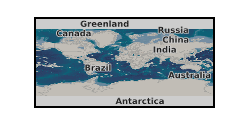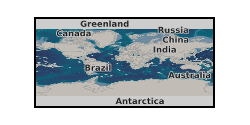Seismic waves
Type of resources
Topics
Keywords
Contact for the resource
Provided by
Years
Formats
Update frequencies
-

This data set contains receiver functions calculated from three-component waveform data available in IRISDMC from 2000 to 2019. The waveform data are for earthquakes greater than magnitude 6.0, depth smaller than 100 km, and epicentral distances between 30 and 95 degrees. The raw waveform data are first converted to displacement and high pass filtered with a corner frequency of 0.02 Hz. Then the waveforms are windowed 20 s before and 400 s after the P arrival for analysis. The vertical-, north- and east-components are rotated to produce the L-, Q-and T-components. Subsequently, the [-20 s, 60 s] portion around the P arrival on the L-component is cut out as a parent waveform and deconvolved from the full L- and Q-components to produce the L- and Q-receiver functions. The data set is organized by year. The receiver functions in each year are compressed into a zip file named by the year when the waveforms were recorded. The receiver functions are in SAC format (https://seiscode.iris.washington.edu/projects/sac), which can be read using the Seismic Analysis Code (https://ds.iris.edu/ds/nodes/dmc/forms/sac/) or the Obspy package (https://github.com/obspy/obspy). The filename contains information of the origin time of the earthquake, the name of seismic network, the name of the seismic station, and component. For example, in the file name ‘TA.Z59A..BHL.M.2013.059.1405.SACD.01’, ‘TA’ stands for the network name, ‘Z59A’ is the station name, ‘BHL’ means the L component, ‘2013.059.1405’ means the earthquake occurred at 14:05 on the 59th day of the year 2013.
-

Open source modeling code, with which all data were generated: https://github.com/kuangdai/AxiSEM-3D This code was primarily developed within the NERC-funded project, and used for a at least 10 publications over the past two years: [1] Wolf, Long, Leng, Nissen-Meyer. Sensitivity of SK(K)S and ScS phases to heterogeneous anisotropy in the lowermost mantle from global wavefield simulations, 2021. GJI, 228, 366–386, https://doi.org/10.1093/gji/ggab347 [2] Krier, Thorne, Leng, Nissen-Meyer: A compositional component to the Samoa ultralow-velocity zone revealed through 2- and 3-D waveform modeling of SKS and SKKS differential travel-times and amplitudes, Journal of Geophysical Research. doi:10.1029/2021JB021897 [3] Thorne, M. S., Leng, K., Pachhai, S., Rost, S., Wicks, J., & Nissen-Meyer, T. (2021). The most parsimonious ultralow-velocity zone distribution from highly anomalous SPdKS waveforms. Geochemistry, Geophysics, Geosystems, 22, e2020GC009467. https://doi.org/10.1029/2020GC009467 [4] Haindl, Leng, Nissen-Meyer, 2021. A 3D Complexity-Adaptive Approach to Explore Sparsity in Visco-Elastic Wave Propagation, Geophysics, doi.org/10.1190/geo2020-0490.1 [5] Tesoniero, Leng, Long, Nissen-Meyer. Full wave sensitivity of SK(K)S phases to arbitrary anisotropy in the upper and lower mantle, Geophysical Journal International, 222, 412–435, https://doi.org/10.1093/gji/ggaa171 [6] Thorne, M.S.; Pachhai, S.; Leng, K.; Wicks, J.K.; Nissen-Meyer, T, 2020. New Candidate Ultralow-Velocity Zone Locations from Highly Anomalous SPdKS Waveforms. Minerals 2020, 10, 211. [7] Fernando, Leng, Nissen-Meyer, 2020. Oceanic high-frequency global seismic wave propagation with realistic bathymetry, Geophysical Journal International, 222, 1178–1194, https://doi.org/10.1093/gji/ggaa248 [8] Leng, Korenaga, Nissen-Meyer, 2020. Three-dimensional scattering of elastic waves by small-scale heterogeneities in the Earth’s mantle, Geophysical Journal International, 223, 1, 502–525, https://doi.org/10.1093/gji/ggaa331 [9] Szenicer, Leng, Nissen-Meyer, 2020. A complexity-driven framework for waveform tomography with discrete adjoints, Geophysical Journal International, https://doi.org/10.1093/gji/ggaa349 [10] Leng, Nissen-Meyer, van Driel, Hosseini, Al-Attar, 2019. AxiSEM3D: broad-band seismic wavefields in 3-D global earth models with undulating discontinuities, Geophysical J Int., 217, 2125–2146 Each of publications is based on the code mentioned above, and metadata for running the simulations of the papers are given therein, in a reproducible manner.
-

Dataset contains 3D synthetic seismic waveforms for axisymmetric global Earth velocity models. The waveforms were calculated using the finite difference approach with the PSVAxi algorithm (Jahnke, G et al., 2008. doi:10.1111/j.1365-246X.2008.03744.x). The Earthmodels are 1D and use PREM parameters except close to the core-mantle boundary (CMB) where 3D ultra-low velocity zones (ULVZs) are added to the PREM background model. ULVZ are thin layers of strongly reduced seismic velocities located at the CMB that have been observed in several regions of the Earth. The dataset models interaction of the seismic wavefield with ULVZ structure with varying elastic parameters (P-wave, S-wave velocity, density), location (location at source or receiver side along the great circle path), ULVZ length, shape (box, Gaussian, trapezoid) and height. Detailed description of the approach and the model space are given in Vanacore et al, (2016). Data format is SAC (Seismic Analysis Code). Vanacore, E.A., Rost, S., Thorne, M.S., 2016. Ultralow-velocity zone geometries resolved by multidimensional waveform modelling. Geophys. J. Int. 206, 659–674. doi:10.1093/gji/ggw114
 NERC Data Catalogue Service
NERC Data Catalogue Service